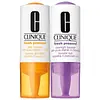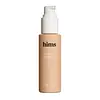What's inside
What's inside
 Key Ingredients
Key Ingredients

 Benefits
Benefits

 Concerns
Concerns

 Ingredients Side-by-side
Ingredients Side-by-side

Water
Skin ConditioningAscorbic Acid
AntioxidantGlycerin
HumectantDimethicone
EmollientSqualane
EmollientButylene Glycol
HumectantDipropylene Glycol
HumectantAcetyl Glucosamine
Skin ConditioningCucumis Sativus Fruit Extract
EmollientHordeum Vulgare Extract
EmollientMorus Nigra Root Extract
Skin ConditioningSaccharum Officinarum Extract
MoisturisingLaminaria Digitata Extract
Skin ProtectingScutellaria Baicalensis Root Extract
AstringentAcetyl Hexapeptide-8
HumectantVitis Vinifera Fruit Extract
Skin ConditioningAlgae Extract
EmollientPalmitoyl Hexapeptide-12
Skin ConditioningPalmitoyl Tripeptide-1
Skin ConditioningPalmitoyl Tetrapeptide-7
Skin ConditioningAlcaligenes Polysaccharides
EmollientCaffeine
Skin ConditioningSucrose
HumectantLactis Proteinum
Skin ConditioningBetaine
HumectantSalicylic Acid
MaskingGlycine Soja Protein
EmulsifyingSodium Hyaluronate
HumectantCaprylyl Glycol
EmollientSigesbeckia Orientalis Extract
Skin ConditioningBis-PEG-18 Methyl Ether Dimethyl Silane
EmollientPropylene Glycol Dicaprate
EmollientHelianthus Annuus Seedcake
AbrasiveAllyl Methacrylates Crosspolymer
Emulsion StabilisingCarbomer
Emulsion StabilisingGlyceryl Polymethacrylate
Tromethamine
BufferingXanthan Gum
EmulsifyingPotassium Sorbate
PreservativePEG-8
HumectantPolysorbate 20
EmulsifyingSodium Citrate
BufferingDisodium EDTA
Phenoxyethanol
PreservativeGlycine Soja Oil
EmollientVinyl Dimethicone/Methicone Silsesquioxane Crosspolymer
Methyl Trimethicone
Skin ConditioningLauryl PEG-9 Polydimethylsiloxyethyl Dimethicone
Skin ConditioningPolysilicone-11
Methyl Gluceth-20
HumectantRetinol
Skin ConditioningOenothera Biennis Flower Extract
AstringentLaminaria Saccharina Extract
Skin ProtectingGelidiella Acerosa Extract
Skin ProtectingCholesterol
EmollientSalvia Sclarea Extract
AntiseborrhoeicAminopropyl Ascorbyl Phosphate
AntioxidantPlankton Extract
Skin ConditioningGlycine Soja Seed Extract
Skin ConditioningMicrococcus Lysate
Skin ConditioningHypnea Musciformis Extract
Skin ProtectingTocopheryl Acetate
AntioxidantSodium Hydroxide
BufferingCalcium Chloride
AstringentAmmonium Acryloyldimethyltaurate/Vp Copolymer
Lecithin
EmollientBHT
AntioxidantSodium Benzoate
MaskingWater, Ascorbic Acid, Glycerin, Dimethicone, Squalane, Butylene Glycol, Dipropylene Glycol, Acetyl Glucosamine, Cucumis Sativus Fruit Extract, Hordeum Vulgare Extract, Morus Nigra Root Extract, Saccharum Officinarum Extract, Laminaria Digitata Extract, Scutellaria Baicalensis Root Extract, Acetyl Hexapeptide-8, Vitis Vinifera Fruit Extract, Algae Extract, Palmitoyl Hexapeptide-12, Palmitoyl Tripeptide-1, Palmitoyl Tetrapeptide-7, Alcaligenes Polysaccharides, Caffeine, Sucrose, Lactis Proteinum, Betaine, Salicylic Acid, Glycine Soja Protein, Sodium Hyaluronate, Caprylyl Glycol, Sigesbeckia Orientalis Extract, Bis-PEG-18 Methyl Ether Dimethyl Silane, Propylene Glycol Dicaprate, Helianthus Annuus Seedcake, Allyl Methacrylates Crosspolymer, Carbomer, Glyceryl Polymethacrylate, Tromethamine, Xanthan Gum, Potassium Sorbate, PEG-8, Polysorbate 20, Sodium Citrate, Disodium EDTA, Phenoxyethanol, Glycine Soja Oil, Vinyl Dimethicone/Methicone Silsesquioxane Crosspolymer, Methyl Trimethicone, Lauryl PEG-9 Polydimethylsiloxyethyl Dimethicone, Polysilicone-11, Methyl Gluceth-20, Retinol, Oenothera Biennis Flower Extract, Laminaria Saccharina Extract, Gelidiella Acerosa Extract, Cholesterol, Salvia Sclarea Extract, Aminopropyl Ascorbyl Phosphate, Plankton Extract, Glycine Soja Seed Extract, Micrococcus Lysate, Hypnea Musciformis Extract, Tocopheryl Acetate, Sodium Hydroxide, Calcium Chloride, Ammonium Acryloyldimethyltaurate/Vp Copolymer, Lecithin, BHT, Sodium Benzoate
Water
Skin ConditioningSodium Ascorbyl Phosphate
AntioxidantPropanediol
SolventGlycerin
HumectantOleth-20
CleansingPEG-12 Dimethicone
Skin ConditioningCitric Acid
BufferingHydroxyethylcellulose
Emulsion StabilisingPhenoxyethanol
PreservativeParfum
MaskingLimonene
PerfumingPropylene Glycol
HumectantEthylhexylglycerin
Skin ConditioningSodium Acetate
BufferingSodium Hyaluronate
HumectantCellulose
AbsorbentCitrus Aurantium Dulcis Peel Extract
Emulsion StabilisingCI 15510
Cosmetic ColorantCitral
PerfumingIngredients Explained
These ingredients are found in both products.
Ingredients higher up in an ingredient list are typically present in a larger amount.
Glycerin is already naturally found in your skin. It helps moisturize and protect your skin.
A study from 2016 found glycerin to be more effective as a humectant than AHAs and hyaluronic acid.
As a humectant, it helps the skin stay hydrated by pulling moisture to your skin. The low molecular weight of glycerin allows it to pull moisture into the deeper layers of your skin.
Hydrated skin improves your skin barrier; Your skin barrier helps protect against irritants and bacteria.
Glycerin has also been found to have antimicrobial and antiviral properties. Due to these properties, glycerin is often used in wound and burn treatments.
In cosmetics, glycerin is usually derived from plants such as soybean or palm. However, it can also be sourced from animals, such as tallow or animal fat.
This ingredient is organic, colorless, odorless, and non-toxic.
Glycerin is the name for this ingredient in American English. British English uses Glycerol/Glycerine.
Learn more about GlycerinPhenoxyethanol is a preservative that has germicide, antimicrobial, and aromatic properties. Studies show that phenoxyethanol can prevent microbial growth. By itself, it has a scent that is similar to that of a rose.
It's often used in formulations along with Caprylyl Glycol to preserve the shelf life of products.
Sodium Hyaluronate is hyaluronic acid's salt form. It is commonly derived from the sodium salt of hyaluronic acid.
Like hyaluronic acid, it is great at holding water and acts as a humectant. This makes it a great skin hydrating ingredient.
Sodium Hyaluronate is naturally occurring in our bodies and is mostly found in eye fluid and joints.
These are some other common types of Hyaluronic Acid:
Learn more about Sodium HyaluronateWater. It's the most common cosmetic ingredient of all. You'll usually see it at the top of ingredient lists, meaning that it makes up the largest part of the product.
So why is it so popular? Water most often acts as a solvent - this means that it helps dissolve other ingredients into the formulation.
You'll also recognize water as that liquid we all need to stay alive. If you see this, drink a glass of water. Stay hydrated!
Learn more about Water